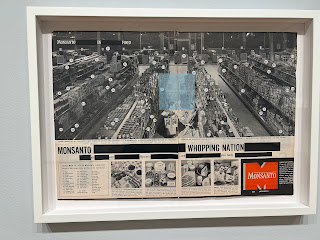The Hidden Truth About Man-Made Chemicals: Toxic Chemicals In the U.S
The Hidden Truth About Man-Made Chemicals: Toxic Chemicals In the U.S
By: Kyanna Gonzalez
In Kirsten Stolle’s exhibit titled Only You Can Prevent a Forest, Stolle used multiple art pieces to highlight the horrific acts major chemical companies commit upon the environment and its people. More specifically, the language and propaganda used by major chemical production companies were showcased in artistic ways, capturing the irony of how chemical agents advertise their products to consumers in the U.S. Positive pop art and bright colors in advertisements found in magazines continue to mask how deadly and problematic these chemicals are when used on a global scale. While research has shown that these chemicals are negatively affecting the environment and human health, these chemicals are still being distributed and used within the United States. Historically, the green revolution introduced the use of pesticides and fertilizers to produce higher-yielding crops and crops in areas that had in-fertile soil. One of the first pesticides to be introduced to the U.S includes DDT, an insecticide that was highly successful but also produced negative effects on the environment and its species by weakening the clutches of bird species like the American bald eagle.
Stolle’s art piece titled Science For A Better Life used magazine advertisements from the 1950s to the 1980s from major chemical companies like Bayer, Monsanto, and Don Chemical that promoted the use of their toxic chemicals and altered the intended message behind the original propaganda. Stolle reconstructed the advertisements using a collage method of art to expose and emphasize the threat and danger behind the use of these products. For example, one advertisement that was reconstructed includes a picture of a grocery store and how Monsanto has improved food through chemicals like additives and preservatives. Stolle blacks out most of the information in the advertisement leaving a few bold words visible to the audience. Phrases like “Monsanto in food”, “eat with Monsanto and your family” and “Monsanto: eat chemistry” are depicted and allow the audience to draw conclusions that chemicals are used to preserve and make our food taste better and could be harmful to human health.
Stolle’s exhibit is important to consider as it provides a visual representation of how toxic commonly used chemicals like pesticides can be to the environment and human health. A contradiction can be found between the positive language used by chemical agents like Monsanto and Don when referring to their chemical products and what the actual chemicals are created and used for; violence.


Comments
Post a Comment